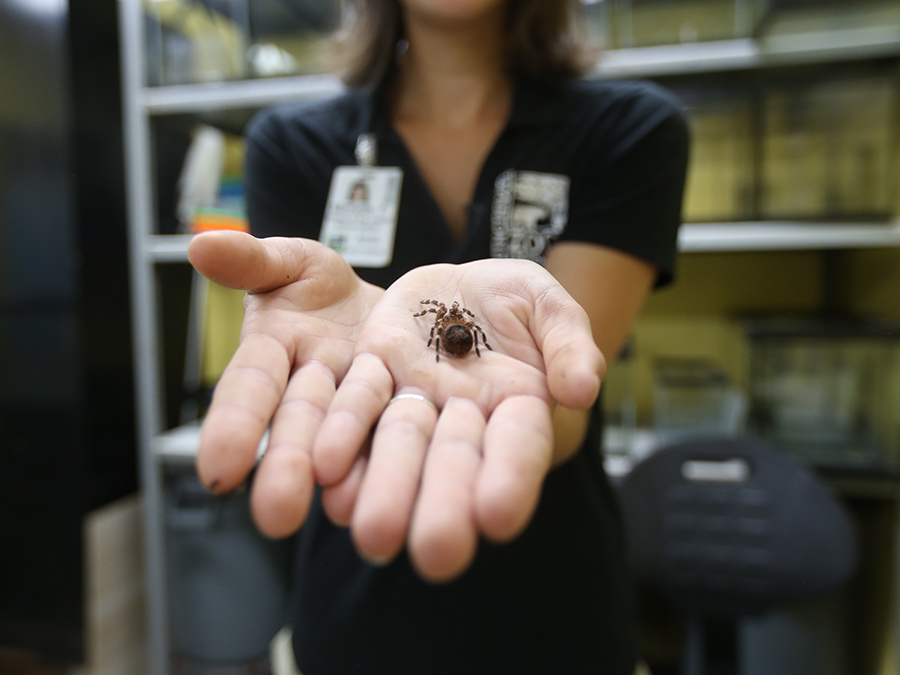CINCINNATI — Several new offspring recently arrived at the Cincinnati Zoo & Botanical Garden in an unconventional way.
The zoo received five Brazilian Whiteknee tarantula spiderlings and two pairs of Hercules beetles larvae from the U.S. Fish and Wildlife Service that were confiscated as part of the illegal wildlife trade.
According to Cincinnati Zoo World of the Insect curator Winton Ray, officials seized the beetles at Louisville International Airport from a group illegally smuggling insects in from the United Kingdom, and the tarantulas were dispersed to several zoos after Fish and Wildlife delivered them to the Woodland Park Zoo in Seattle.
While the Cincinnati Zoo’s newest insect arrivals are all healthy and adjusting to their new home, Ray said, that’s not always the case for animals illegally shipped into the country.
“They’re often not put in the best situation,” he said. “For instance, parrots can be wrapped and taped up, then put into very small boxes or stuffed into athletic shoes. Because people go to extreme measures to avoid being detected by security, all kinds of animals face the risk of dying in transit or arriving at their destination very distressed.”
While exotic birds and reptiles are the most well-known commonly trafficked animals, Ray said the illegal wildlife trade encompasses every variety of animal and insect imaginable. He said some collectors build habitats for their animals that would rival zoos, but the exotic pets often end up in basements or cramped enclosures. He said unfortunately many people realize they’re not equipped to care for the animals, then simply turn them loose into the wild.
“There’s always the potential that this animal could become an invasive species,” he said. “And that’s happened in the southern U.S. and Florida, especially with Burmese pythons, Nile monitors and a species of caiman that’s become established.”
According to U.S. Fish and Wildlife Service public affairs specialist Christina Meister, globally billions of dollars are spent each year on the illegal wildlife trade. To identify trafficking into the United States, she said, the agency posts frontline wildlife inspectors at airports and cargo centers, places special agents undercover and identifies animal remains and cause of death at the agency’s forensic lab in Oregon.
She said many animals are killed to be made into jewelry, accessories or medicine. After being seized, she said, those items then go to the agency’s National Wildlife Repository in Denver.
“We house them at the repository and it’s kind of their final stop,” Meister said. “We actually lend the items to zoos, education centers and schools to help educate the public about the illegal wildlife trade. So they end up there, but they serve a purpose as ambassadors for their species.”
Because many illegally traded insects are considered invasive species, Ray said, both the tarantulas and Hercules beetles likely would have been destroyed after being seized without the option of professional care. He said since receiving the youth, zoo staff’s mission now is to raise them to healthy adults. The tiny tarantulas are currently about the size of a quarter, but Ray said the females will grow to about 6 to 7 inches. They can produce up to 600 to 1,000 fertilized eggs and live up to 20 years, Ray said; the far smaller males live only about five years.
“Pretty much any tarantula that you see displayed at a zoo or museum, you can figure it’s a female,” he said. “And given the physiological stress of producing that many eggs, you would think it would be the females with the shortest life, but no.”
Cincinnati Zoo senior insect keeper Michelle Faehr said raising the enormous Hercules beetles is an extended process. She said during the pupa stage, they constantly eat wood and leaves while buried in the ground, then excrete a byproduct that becomes rich soil. Eventually they create a solid casing where they transform into a beetle.

“It’s a long process, but the outcome is really cool,” she said. “They will be totally enclosed until they pop out and emerge as adults. It takes them two years from hatching to adult and then they live about six to eight months after.”
A male Hercules beetle can reach up to 7 inches in length, Faehr said, including an impressive set of horns used for self-defense and wings for flight. According to Ray, people purchasing the species will pay anywhere from $200 to $300 for an illegal pair of larvae. He said many collectors take great care of their animals, but importing any illegal species can have lasting repercussions.

“It’s a problem on multiple levels,” he said. “Many of these animals are being bred in human care, but a lot of them are being illegally collected and harvested from the wild, so you’re putting a drain on populations that are already under pressure.”
At U.S. Fish and Wildlife, Meister said the agency’s goal is to stop trafficking before animals are in transit. Once seized, a variety of factors come into play, she said, including the health of the animal, health risks to humans and native ecosystems and the species’ country of origin.
“The Service works with federal agencies such as U.S. Customs and Border Protection and the U.S. Department of Agriculture and other partners to protect our nation's borders and facilitate legal trade at U.S. ports of entry,” she said.








